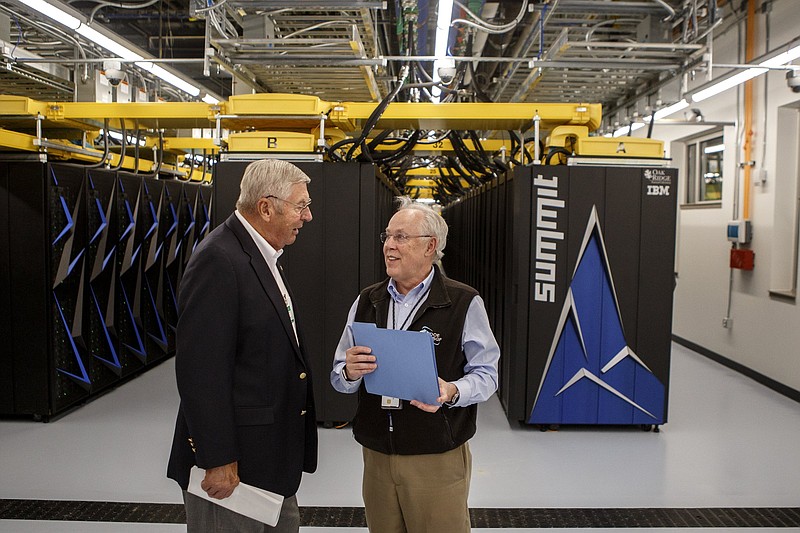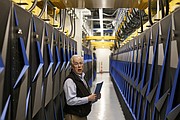OAK RIDGE, Tenn. - When the Oak Ridge National Laboratory was competing with other U.S. labs a decade and a half ago to gain the world's fastest computer to catch up with the Japanese Earth Simulator supercomputer, Oak Ridge was not initially regarded as the favorite U.S. site.
"One of our biggest challenges in being successful at that time was that we did not have very good high-speed connectivity to this laboratory here in East Tennessee," said Dr. Thomas Zacharia, the ORNL director who was heading the computing team at Oak Ridge at the time.
Zacharia, an Indian-born computational scientist who has lead Oak Ridge's computational team bring a series of the world's fastest computers to Oak Ridge during his 32-year career here, recalls meeting then Chattanooga Mayor Bob Corker for the first time in the mid 1990s when the two began discussing how to use TVA fiber optic links through East Tennessee to connect Oak Ridge computers with Chattanooga.
Corker was pushing the start up of Metronet, a city-backed venture that became the predecessor to EPB's Fiber Optics, and Corker wanted to connect Oak Ridge's computers to the Sim Center which had recently relocated to the University of Tennessee at Chattanooga. The computer links would use dark fiber lines along rail lines and other intercity links to eventually connect ORNL and the Sim Center to researchers in Atlanta, Nashville and ultimately on to Chicago.
Computing power grows
The number of floating point operations computers can handle per second is increasing exponentially1988 — Gigaflops —1 billion1998 — Teraflops — a trilion or one million million (or 10 to the 12th power)2008 — Petaflops — a quadrillion or one thousand million million (or 10 to the 15th power)2021 — Exaflops — a quintillion or billion billion (10 to the 18th power)Source: Oak Ridge National Laboratory
"Suddenly, we were able to solve our infrastructure problem that made us a competitive proposal," Zacharia said.
The U.S. Department of Energy ultimately decided to build the world's fastest computers at ORNL, the government's oldest and biggest research lab. Since 2009, three successive computer systems - the Jaguar, Titan and Summit - have been rated the world's fastest computers.
In May, Energy Secretary Rick Perry announced that Oak Ridge would get one of the world's first exascale computers, dubbed the Frontier built by Cray Inc. and Advanced Micro Devices. The $600 million Frontier computer system is expected to go into operation here in 2021 and will be the largest of three exascale computers planned by the Energy Department, including the Aurora and El Capitan computers at the Argonne National Laboratory in Illinois and the Lawrence Livermore National Laboratory in California.
"We are determined to keep America at the forefront of the computing parade," Perry said during an announcement of the Frontier computer in Oak Ridge.
U.S. Sen. Lamar Alexander, R-Tenn., a member of the Senate Appropriations Committee who pushed for Oak Ridge to get the latest supercomputer, insists the federal government needs to invest in the Frontier to maintain America's technology advantage.
"China, Japan, the U.S., and the European Union all want to be first in advanced computing," Alexander said this spring when the Frontier project was announced. "The stakes are high because the winner has an advantage in such things as advanced manufacturing and artificial intelligence."
Zacharia sees the new faster and smarter computers as a kind of window to the future that allows researchers and product developers a head start on the rest of the world. He likens the super computers to a time machine.
"Computers allow us to move forward in time, by my estimation, a good 20 years," Zacharia said. "The fastest computers we deploy at this laboratory will take about 20 years or so before it is generally available to the population.
The fastest computer in the world in 1995, which was at Oak Ridge and in San Diego, is now readily available in the pockets of nearly 2 billion people who own an iPhone 6 or better, Zacharia said.
"That is the pace of change that is occurring and that is the competition brought about by information technology," Zacharia said. "The reason we do this is to give the United States a 20-year head start. We have the power of the fastest computer in the world that only the richest country in the world with the talent and expertise of lab such as this can create."
Zacharia said the computer advances at Oak Ridge underscore Moore's Law, which asserts that the number of transistors on a microchip doubles every two years, though the cost of computers is halved. Another tenet of Moore's Law is that this growth in the microprocessor industry is exponential-meaning that it will expand steadily and rapidly over time.
The Summit supercomputer at Oak Ridge National Laboratory remains the world's fastest and most powerful, according to the latest TOP500 ranking.
The Summit has a peak performance capability of 200,000 trillion "floating point operations" - or petaflops - per second. To match what the Summit can do in one second, the entire population of the world would have to compute one operation per second around the clock for 305 days.
But the Frontier computer is expected to be about five times faster, capable of handling more than a quintillion calculations per second.
"We want this machine on day one to solve the world's toughest challenges," said Lisa Su, president of Advanced Micro Devices.
Oak Ridge’s fastest computers
Over the past decade, Oak Ridge National Laboratory has hosted the world’s fastest computers and is expected to maintain that lead into at least the next decade› Jaguar — 18 teraflops in 2005; upgraded in 2009 performing at 2.3 petaflops (named world’s fastest in November 2009)› Titan — 27 petaflops in 2012; debuted as world’s fastest supercomputer in 2012 and remained in the Top 10 fastest supercomputers in the world until June 2019› Summit — 200 petaflops in 2018; named world’s fastest in June and November 2018 and June 2019› Frontier — expected to be 1.5 exaflops and scheduled to be delivered in 2021 (Frontier will be the largest of 3 exascale systems being built by DOE. The others being El Capitan at Lawrence Livermore National Laboratory and Aurora at Argonne National Laboratory.)Source: TOP500 List
The Department of Energy began developing the supercomputers in the 1990s as a way to maintain the readiness of America's nuclear stockpile by conducting simulated tests without having to do actual detonation testing.
"That required computer simulations capable of modeling nuclear processes down to tiny fractions of a second," Jack Dongarra, a University of Tennessee in Knoxville professor and researcher at ORNL, wrote last year in The Washington Post. "No computer on the planet was capable of such precision, so the department embarked on a campaign that would raise the processing speed of the world's best computers by a factor of 10,000."
The super computers in Oak Ridge perform military and nuclear simulations. Just as Oak Ridge moved from its atomic bomb development in World War II to research to subsequently develop new nuclear medicines, energy, transportation and materials, the super computers are being used by an array of private and public researchers for studies in a variety of fields from artificial intelligence, bioresearch, transportation, physics, chemistry and nuclear power.
James Hack, director of ORNL's National Center for Computational Sciences, said the super computers have been used by General Electric, Pratt & Whitney and a host of other businesses, along with military and academic research projects.
"Every six months we put out a call for proposals from those using the machine in a leadership way so we tend to have a relatively small number of projects that use our capability for pioneering ventures," Hack said.
The development of the super computers themselves have also helped fuel business successes. In 2009, for instance, Jen-Hsun "Jensen" Huang, the co-founder of the the graphics-processor company Nvidia, operated what was then strictly a gaming company with about $20 billion in sales. Jensen agreed to develop a processor for ORNL's super computers and its research effort helped to also boost Nvidia into one of the biggest IT companies in the world.
When Jensen came back to Oak Ridge last year to launch the Summit computer , his company had a market value exceeding IBM.
"The brains behind Tesla came out of Oak Ridge," Zacharia said. "Computing is a priority for this laboratory. The national labs are structured to respond to national needs and therein lies both the opportunity and the challenge."
Contact Dave Flessner at dflessner@timesfreepress.com or at 423-757-6340.

